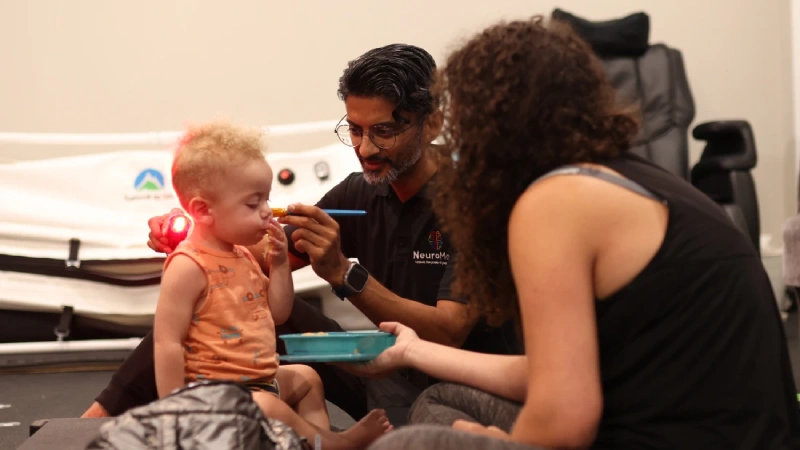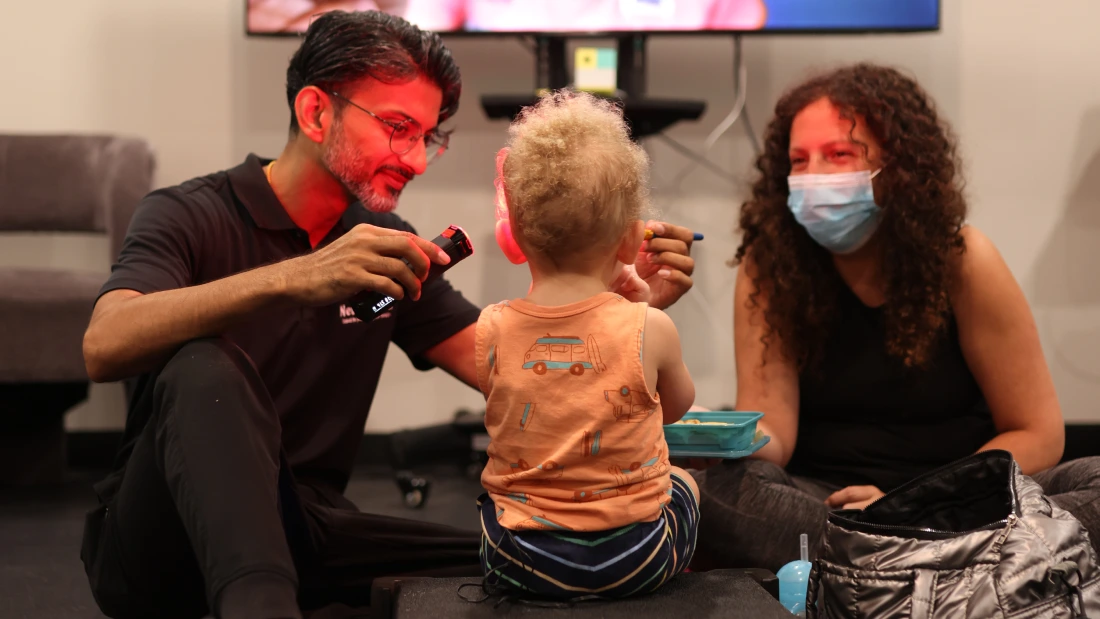
How Neuromodulation Therapy Helps Children with Autism
Neuromodification treatments are revolutionizing care for children with Autism Spectrum Disorder (ASD), by providing a safe, effective, and non-invasive solution. Specifically, Neuromodulation Therapy is an innovative approach that leverages the brain’s neuroplasticity to enhance function and support self-rehabilitation, helping children develop essential skills.
Using advanced technologies, neuromodification gently stimulates the brain to optimize its ability to process information, regulate emotions, and support social interactions. Easily administered in outpatient settings, these treatments offer hope and measurable improvement in a child’s development.
But what exactly is Neuromodulation Therapy? How do they work, and what benefits can they offer your child? Let’s dive into the answers to these common questions and explore how these transformative treatments reshape autism care.
What Is Neuromodulation Therapy?
Neuromodulation Therapy targets brain activity to promote growth, connectivity, and optimal functioning. By harnessing the brain’s natural ability to adapt, known as neuroplasticity, these treatments strengthen underactive neural pathways while calming overactive areas.
For children with autism, neurological modification therapy addresses common challenges, including:
- Communication delays and speech difficulties
- Sensory sensitivities or processing disorders
- Emotional regulation challenges and anxiety
- Behavioral difficulties
- Social interaction struggles
Unlike traditional methods, these therapies deliver faster results by using child-friendly technologies to enhance brain function—without the need for needles or medications. The best part? They provide a safe, comfortable, and even enjoyable experience for kids.
Why Is Neuromodulation Ideal for Treating Children?
Children’s brains are highly adaptable, particularly during early developmental years. Neurological Modification Therapy leverages this critical window of opportunity to optimize brain networks before they become rigid. Research has shown that neuromodulation therapy can lead to:
- Improved speech and language development
- Enhanced attention and focus
- Better emotional stability
- Stronger social interaction skills
- More consistent behavioral regulation
As more families discover the benefits, this method is gaining recognition as a powerful alternative or complement to traditional treatments.
How Neuromodulation Therapy Works?

Here are some key areas where Neurological Modification Therapy can make a difference:
1. Primitive Reflex Integration
Primitive reflexes are automatic movements present at birth that typically fade during early development. For children with autism, these reflexes often persist, leading to sensory, motor, and emotional challenges.
- How It Works: Exercises and movements are used to suppress outdated reflexes, allowing higher brain functions to take control. For example, integrating the Moro reflex (startle response) reduces hypersensitivity and anxiety, leading to a calmer nervous system and better coordination.
2. Brain Balancing
Brain balancing focuses on synchronizing activity between the brain’s hemispheres. Children with autism often experience an imbalance, which affects sensory processing, emotional regulation, and motor skills.
- How It Works: Techniques such as rhythmic exercises, cross-body movements, and sensory integration activities promote communication between hemispheres, improving emotional control, sensory processing, and overall coordination.
3. Sensory Integration Therapy
Sensory processing challenges can lead to sensory-seeking or avoidant behaviors, which affect a child’s ability to engage with their environment.
- How It Works: Activities such as swinging, using weighted blankets, or interacting with textured surfaces help the brain process sensory input more effectively. This reduces sensory overload and enhances focus, engagement, and daily functioning.
4. Emotional Regulation Training
Children with autism often struggle to manage emotions, leading to meltdowns or anxiety.
- How It Works: Neuromodification techniques, including neurofeedback and mindfulness training, help regulate the brain’s emotional centers. These methods build self-awareness, resilience, and the ability to handle stress in social and everyday situations.
What Technologies Use Neuromodulation Therapy?
Neuromodification therapies rely on advanced tools to provide effective, non-invasive solutions. Some of the key technologies include:
- Magnetic Coils (for TMS): Transcranial Magnetic Stimulation (TMS) uses painless magnetic pulses to stimulate brain areas involved in attention, behavior, and emotional regulation.
- Electrode Caps (for tDCS/Neurofeedback): These caps deliver gentle electrical stimulation or monitor brainwave activity to improve focus, relaxation, and cognitive function.
- Light Devices (for PBM): Photobiomodulation Therapy (PBM) uses therapeutic light wavelengths to boost cellular activity in the brain, enhancing cognitive and emotional performance.
These technologies work seamlessly with real-time EEG monitoring, AI-driven software for personalization, and ABA techniques to reinforce positive changes.
Common Neuromodification Methods for Treating Children with Autism

Some of the most widely used non-invasive neuromodulation therapies for autism include:
- Transcranial Magnetic Stimulation (TMS): Delivers magnetic pulses to improve emotional regulation, focus, and behavior. By targeting areas of the brain linked to ASD symptoms, TMS encourages improved communication between neural pathways.
- Neurofeedback Therapy: Trains the brain to self-regulate through engaging activities and real-time brainwave monitoring. Children participate in activities, such as watching videos or playing games, while the system trains their brains to self-regulate. It acts to enhance concentration and attention and reduce anxiety or stress.
- Transcranial Direct Current Stimulation (tDCS): Uses gentle electrical currents to enhance brain plasticity, supporting speech, problem-solving, and emotional resilience. The process is quick, safe, and can be integrated into other therapy programs for comprehensive support.
- Photobiomodulation Therapy (PBM): Emits therapeutic light wavelengths to boost brain cell activity and reduce anxiety. This method has been shown to support cognitive and emotional regulation, improve mood, and reduce anxiety. PBM is painless and has no known side effects.
- Auditory Integration Training (AIT): Improves auditory processing and reduces sensory sensitivities with sound-based exercises. Children listen to specially designed music to help their brains adapt to and filter sounds more effectively, enhancing communication skills and reducing sensory sensitivities. This therapy is particularly helpful for children who struggle with sensory overload or hypersensitivity to noise.
- Virtual Reality-Based Therapy (VR): Engages children in interactive scenarios to build social and communication skills. VR therapy helps children practice recognizing facial expressions, navigating social situations, and developing problem-solving skills, in a controlled, fun environment.
- Cognitive Behavioral Therapy (CBT) with Technology: Combines CBT with tools like neurofeedback or VR for enhanced emotional and behavioral management. With added tech-based tools, the therapy becomes even more engaging and targeted.
Is Neurological Modification Therapy Right for Your Child?
If your child struggles with communication, social skills, or sensory sensitivities, neuromodification could be a life-changing solution. These therapies address root causes, offering new opportunities for growth and development in a safe and supportive environment.
Take the Next Step with NEUROMOD™
At Koala ABA and Learning Center, an autism treatment center in Florida, we’ve developed NEUROMOD™. This innovative program combines FDA-approved EEG machines, advanced medical lasers, AI-powered software, and specialized ABA techniques to regenerate and modify neurological connections within the brain. Our Neuromodulation therapy is designed to go beyond conventional treatment methods for children with autism, offering hope and transformative changes for those with neurological conditions. Let’s work together to unlock their full potential. Discover how neuromodification can transform your child’s development. Reach out now for a consultation!

